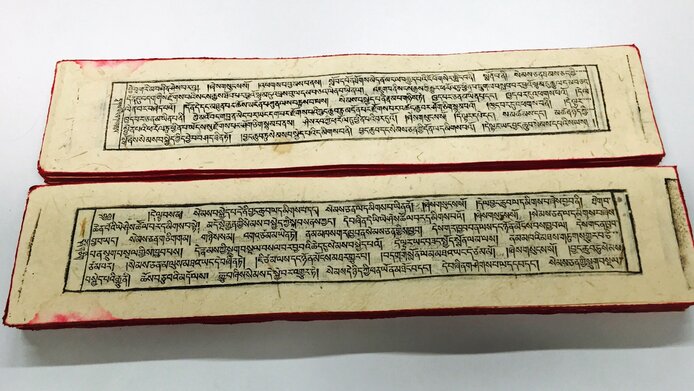Viennese researchers investigate the history of Tibetan philosophy

The mahāmudrā yoga and meditation techniques have been attracting worldwide interest for some time. “In the intellectual history of Tibet, these traditions played a crucial role”, explains Klaus-Dieter Mathes from the University of Vienna. Since 2012, the Tibetologist has been studying important works by influential masters of Tibetan Buddhism within the context of an FWF project and has thus performed valuable groundwork.
Processing traditional sources of history
The researcher’s most important sources are old manuscripts from the 15th and 16th centuries, many of which Klaus-Dieter Mathes studied on the spot and saved on microfilm himself in the 1990s, when he headed the Nepal Research Centre. Since the Tibetan government went into exile, several of these centuries-old texts have only been accessible in Tibetan enclaves located in the North of Nepal. In close co-operation with Indologists, Buddhologists and Tibetan scholars, a team headed by Mathes has now identified and critically edited Tibetan Buddhist works and compared them with their Indian originals to the extent these were available. As there existed no previous systematic analysis of the texts about mahāmudrā, nor an attempt to investigate the development and complex relationship of this body of teaching with earlier tendencies in Indian Buddhism, these studies represent an important contribution to the history of Tibetan philosophy.
Emptiness as a central element of the Buddhist world view
The term mahāmudrā comes from Sanskrit and literally translates as “great seal”. The “seal” represents emptiness or the absence of inherent existence, and its greatness is a consequence of its being the true nature of all phenomena. The realization of emptiness brings great bliss. In this way mahāmudrā also represents the Buddha’s unity of bliss and emptiness. “We have been studying how emptiness and dependent arising were interpreted in the post-classical era of Buddhism”, Mathes notes. These two central aspects condition one another. In Buddhist teaching, ‘dependent arising’ signifies that the world is a system of dynamic interaction. Everything exists only in relation to other things, which reduces the importance of the self.
Buddha nature – the potential of all beings
From this emptiness is established. For, it is only the absence of inherent existence, i.e. the emptiness of own-nature, which enables things to interact with each other in the first place. The recognition of emptiness brings the realisation of the true nature of one’s own mind or so-called Buddha nature. Although the Buddha virtues, limitless love and wisdom, have forever been connected with the personality stream of every living being, they are usually impossible to realise because of external spiritual “stains” such as ignorance, craving or hatred. Scholars like to compare the realisation of the Buddha nature with the image of agitated water which appears muddied. Through the practice of meditation, the mud will settle and the purity of the water becomes apparent. The notion of “emptiness of other” is used in this context, meaning that the Buddha nature is devoid of external impurities and that such impurities do not touch the true nature of mind.
The heyday of mahāmudrā tradition
The philosophy based on mahāmudrā was taught systematically mainly in the Bka’ brgyud schools of Tibet from the 15th and 16th centuries onward. At that time, the Bka’ brgyud pas held economic and political power, and some of the rulers of central Tibet came from their ranks. “During that period there was a great deal of dialogue and exchange between different schools”, notes Mathes. “Discussions were held at a high level about the various forms of emptiness.” In the project, the international team headed by Klaus-Dieter Mathes investigated what schools of thought existed and which positions were taken by individual authors. In the process, the scientists from the University of Vienna were also able to answer fundamental questions of philosophy and religion, such as the relationship between the profane and the sacred. As of the 17th century, the Bka’ brgyud pas lost their influential position, and thus the mahāmudrā tradition became endangered as the monasterial universities forfeited their material underpinning.
Personal details Since 2010, Klaus-Dieter Mathes has been teaching and conducting research at the University of Vienna, where he heads the Department of South Asian, Tibetan and Buddhist Studies. Mathes previously held a position at the University of Hamburg, inter alia as head of the Nepal Research Centre. The Tibetologist has stayed in Nepal frequently and owns a valuable collection of manuscripts and blockprints on Tibetan Buddhism.
Publications






